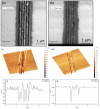Morphological Study of Nanostructures Induced by Direct Femtosecond Laser Ablation on Diamond
- PMID: 34065403
- PMCID: PMC8160903
- DOI: 10.3390/mi12050583
Morphological Study of Nanostructures Induced by Direct Femtosecond Laser Ablation on Diamond
Abstract
High spatial frequency laser induced periodic surface structure (HSFL) morphology induced by femtosecond laser with 230 fs pulse duration, 250 kHz repetition rate at 1030 nm wavelength on CVD diamond surface is investigated and discussed. The spatial modification was characterized and analyzed by Scanning Electron Microscopy (SEM), Atomic Force Microscopy (AFM) and 2D-Fast Fourier Transform (2D-FFT). We studied the effect of pulse number and laser power on the spatial development of nanostructures, and also deduced the impact of thermal accumulation effect on their morphology. A generalized plasmonic model has been used to follow the optical evolution of the irradiated surface and to determine the periodic value of the nanostructures. We suggest that non-thermal melting and plasmonic excitation are the main processes responsible for the formation of HSFL-type nanostructures.
Keywords: 2D-FFT; LIPSS morphology; femtosecond laser; plasmonic excitation.
Conflict of interest statement
The authors declare no conflict of interest.
Figures











References
-
- Gattass R.R., Mazur E. Femtosecond laser micromachining in transparent materials. Nat. Photonics. 2008;2:219–225. doi: 10.1038/nphoton.2008.47. - DOI
-
- Mottay E., Liu X., Zhang H., Mazur E. Industrial applications of ultrafast laser processing. MRS Bull. 2016;41:984–992. doi: 10.1557/mrs.2016.275. - DOI
-
- Chichkov B.N., Momma C., Nolte S., von Alvensleben F., Tünnermann A. Femtosecond, picosecond and nanosecond laser ablation of solids. Appl. Phys. A. 1996;63:109–115. doi: 10.1007/BF01567637. - DOI
-
- Bonse J., Hohm S., Kirner S.V., Rosenfeld A., Kruger J. Laser-Induced Periodic Surface Structures—A Scientific Evergreen. IEEE J. Sel. Top. Quantum Electron. 2016;23:9000615. doi: 10.1109/JSTQE.2016.2614183. - DOI
-
- Wu Q., Ma Y., Fang R., Liao Y., Yu Q., Chen X., Wang K. Femtosecond laser-induced periodic surface structure on diamond film. Appl. Phys. Lett. 2003;82:1703–1705. doi: 10.1063/1.1561581. - DOI
LinkOut - more resources
Full Text Sources
Miscellaneous

